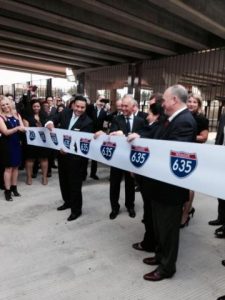U.S. Department of Transportation – Research & Innovative Technology Administration
 In Texas, they’re used to doing things in a big way and the new LBJ Express in Dallas is no exception. Today’s opening of this project was big in a number of ways.
In Texas, they’re used to doing things in a big way and the new LBJ Express in Dallas is no exception. Today’s opening of this project was big in a number of ways.
Big as in a $2.6 billion project, including $1.2 billion in federal aid, including a big ($850 million) loan from our Transportation Infrastructure Finance and Innovation Act (TIFIA) program.
The LBJ Express also rebuilds one of the busiest stretches of roadway in north Texas and in the process, improves mobility by nearly doubling the road’s existing capacity and adding managed toll lanes. That’s important when you live in America’s second-fastest growing city.
The project spans 16 miles and includes general purpose lanes and managed TEXpress toll lanes on I-635 and I-35. These lanes will use variable congestion pricing to keep traffic moving at or around 50 mph. This is good news for commuters in the Dallas-Fort Worth-Arlington region, who spend an average of 53 hours every year in traffic jams, back-ups, and daily commuting gridlock.
And, LBJ Express isn’t arriving behind schedule or even just in time; it’s arriving ahead of time. The LBJ Express team used the Design-Build project delivery method –one of our Every Day Counts innovations– to get it completed three months early.
Between May 2013 and May 2014, the Dallas-Fort Worth region –already America’s fourth-largest metro area– added more than 131,000 new residents. And managing that growth means managing mobility. LBJ Express is leading the way with new and improved lanes and roads that will give travelers better options for getting to and from Dallas safely.
But congestion is a national problem that demands a national solution. That’s why we need a big, long-term transportation bill that makes a sizeable investment in our infrastructure and gives state and local planners the time to put that investment to work.
So, note to Congress: If you want to think big and build big, like Texas does, then look no further than the Obama Administration’s GROW AMERICA proposal, which includes $6 billion over six years for the TIFIA program, an investment that could support $60 billion in loans and credit to help other cities do what Dallas has done.
To read the full article, click here.